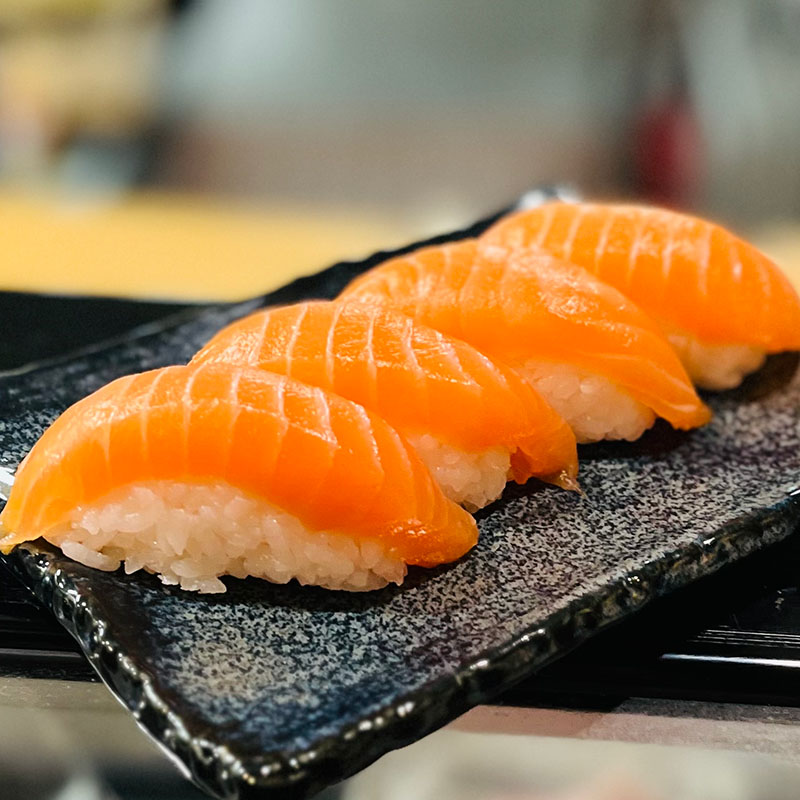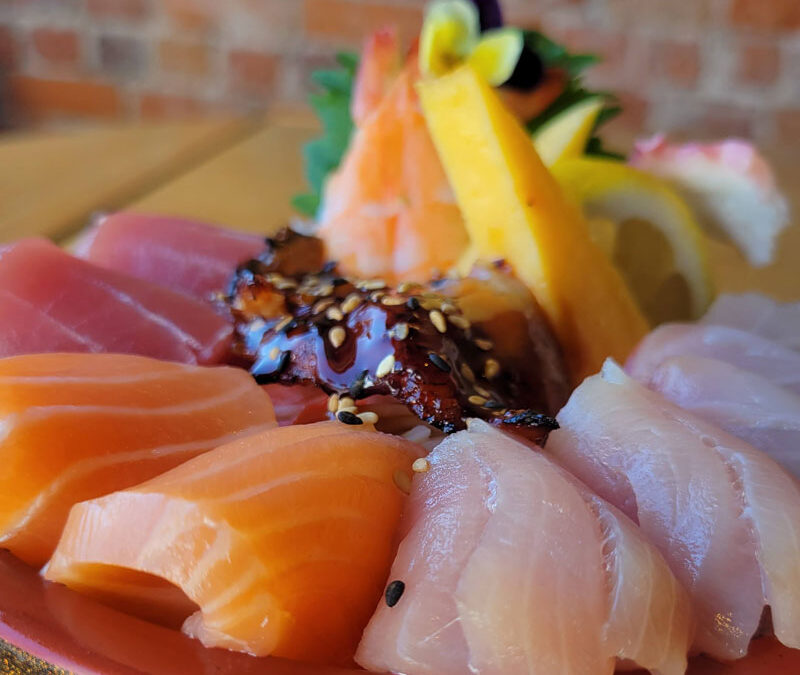Love sushi? Interested in learning more about the Japanese culinary staple? If so, you’re in luck as we’re covering the art of sushi – what it is, its history in the United States, how it’s traditionally eaten. Let’s jump right in!
Types of Sushi at Karma’s Sushi Bar
At Karma Sushi Bar & Grill in Flagstaff, you’ll find the following options when ordering sushi. To learn more about specific items, view our menu.



Sashimi
Sashimi isn’t exactly sushi, although it’s commonly thought of when mentioning the word. It is, in fact, not a type of sushi as it is simply sliced raw fish that’s served without rice.
Sashimi is traditionally eaten with chopsticks.
Nigiri
Nigiri is sliced raw fish that is served on a bed of rice. Typically, these pieces of sushi are in a rectangular or oval shape and are hand pressed as opposed to rolled-out.
Traditionally, nigiri is eaten by hand and sometimes lightly dipped into soy sauce.
Maki
Maki might be the most recognizable type of sushi, which is rolled rice and fish wrapped in dried seaweed. Maki also is traditionally eaten with your hands.
Hosomaki
Hosomaki rolls are smaller in size than their maki sushi kin, but are similar in that they are wrapped in seaweed. Like nigiri, hosomaki is often eaten by hand and lightly dipped into soy sauce for a bit of saltiness.
Sushi in America
Let’s take a brief look at the history of sushi in the United States and where it is today.
According to The New York Times, the first modern sushi bar in the country was Kawafuku in Los Angeles’ Little Tokyo back in the mid-1960s.
A few years later, in 1970, Osho also opened in Los Angeles, but their location was strategically placed near to 20th Century Fox studios in effort to attract celebrities and producers. A move that could have been the catalyst for sushi to become mainstream.
Japan’s tech and economic growth during the 1980s brought more Japanese stateside and more Americans to the Land of the Rising Sun, which further helped sushi’s popularity. This rise in interest led to more Japanese chefs arriving stateside ready to share their nation’s traditional fare and its flavors.
Fast-forward to today and you’ll find sushi restaurants from coast-to-coast and in just about every mid-size town thanks to air travel making the availability of fresh fish commonplace.
How is Sushi Eaten in Japan
To understand how sushi is traditionally consumed in Japan, let’s compare how it’s eaten in the United States.
While sushi in the U.S. has become fundamentally Americanized, the differences between Japan have diminished in recent decades. Here are a few of the distinctions:
- In Japan, sushi is still mostly eaten at small, bar-style eateries rather than traditional table-seating restaurants.
- Japanese sushi bars typically don’t have the same variety of sushi their American counterparts have.
- It’s not uncommon for patrons to order their sushi piece by piece in Japan with a roll coming at the end of a meal. In America, we tend to order bigger with sushi rolls being part of the main dish.
When it comes to eating sushi etiquette, it could be construed as impolite towards the chef to add wasabi to your sushi in Japan. It’s even believed by some traditionalists that the use of chopsticks diminishes the experience.
When using hands to eat sushi, you’d likely see the person picking up a piece between their thumb and middle finger, while using their pointer finger to hold the piece together if needed.
Wasabi is sometimes added to sushi in the making of rolls, but it wasn’t usually mixed with soy sauce for a variety of culinary reasons. Namely, it messes with the natural flavors of the fish and rice.
When wasabi is added to sushi, it’s often done so by Japanese in a small amount on one side of the piece, allowing the opposite side to be dipped in soy. This allows for a proper balance of flavors and lets you taste different flavor profiles without overwhelming your senses with wasabi’s spiciness.
Ginger is served as a palate cleanser so that you can appreciate the different seafood and preparation that goes into each piece of sushi. You eat the ginger between different pieces, which gives tastebuds a reboot.
The Next Time You Have Sushi…
A few things to keep in mind for the next time you have sushi. First, your sushi chef isn’t a noble samurai warrior. He (or she) may be noble, but more like you than pop culture has led you to believe. So spark up a conversation, ask for recommendations, and see for yourself how sushi can be best enjoyed.
Similarly, if you’re not a sushi aficionado, ask the wait staff to recommend a dish based on your preferences. You might also ask about drink pairings, such as Japanese beers, wines, or saki.
Don’t feel as though you need to figure out how to use chopsticks. Use your hands or even a fork if it’s easier for you. Tradition often takes a backseat to an enjoyable dining experience.
If you’re in Flagstaff or planning a visit, we’d love to have you! Feel free to stop by, chat with our staff, and enjoy a fresh, delicious sushi dinner. You’ll love Karma’s ambience, friendly patrons, and, most of all, our chef’s sushi creations! We take reservations, offer takeout, have party platters, happy hour deals, and more. Contact us today to learn more.

